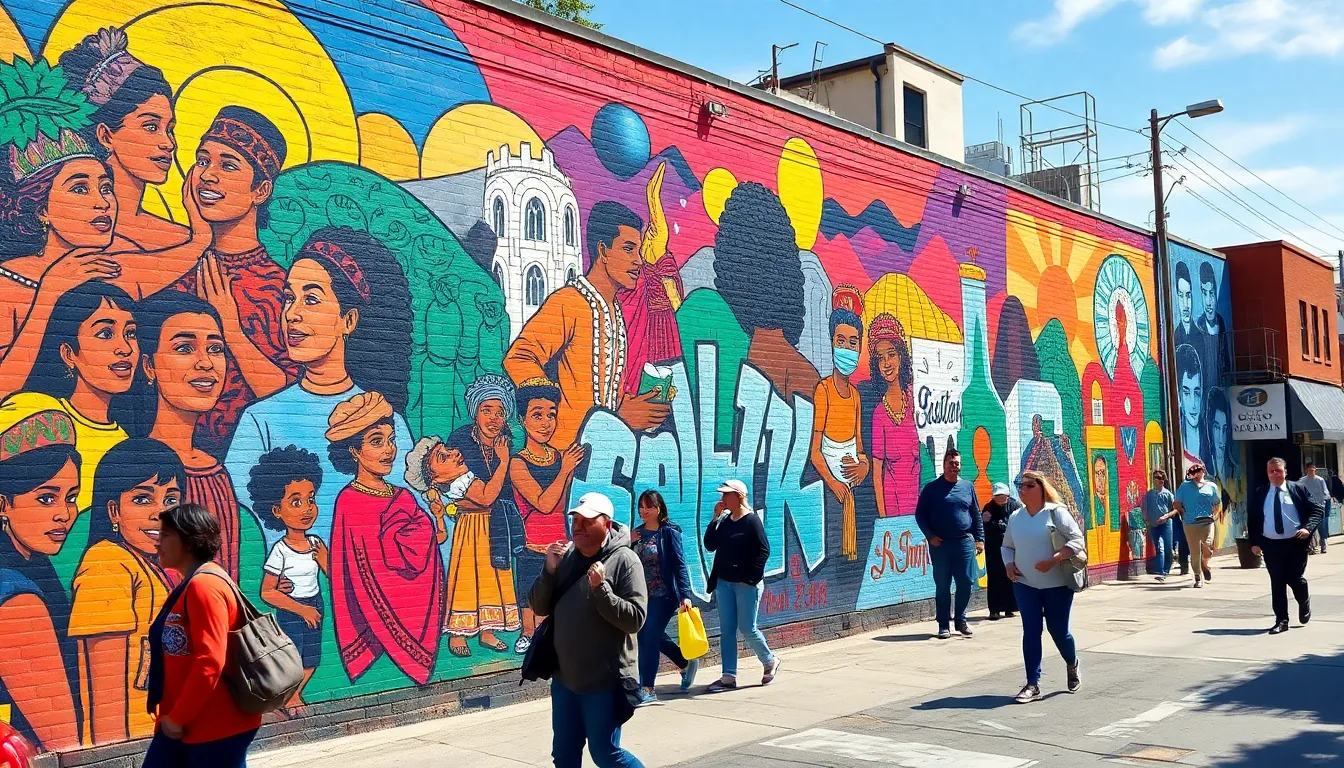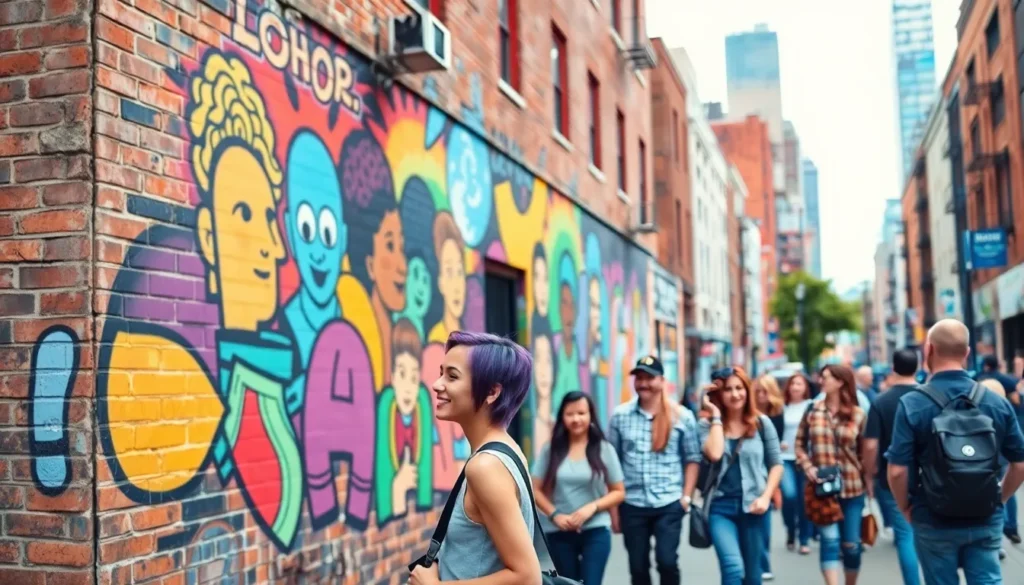In every city, there’s a vibrant world waiting to be discovered, and it’s not just in the galleries. Local street art transforms dull walls into canvases bursting with life, color, and creativity. It tells stories, sparks conversations, and sometimes even makes you question your life choices—like why you thought that haircut was a good idea.
From whimsical murals to thought-provoking graffiti, street art captures the essence of a community. It’s like a treasure hunt where the prize is a glimpse into the heart and soul of a neighborhood. So grab your camera and your sense of adventure, because exploring local street art is not just a stroll; it’s an experience that’ll leave you inspired and possibly giggling at the absurdity of it all.
Table of Contents
ToggleOverview Of Local Street Art
Local street art serves as a creative expression that reflects community identity. Artists use walls as canvases, creating pieces that resonate with residents and visitors alike. Murals, graffiti, and installations often highlight social issues, celebrate cultural heritage, or simply add color to urban environments.
Cities around the world boast diverse street art scenes. In New York City, for instance, neighborhoods like Bushwick and Williamsburg feature vibrant murals that attract tourists and locals. Los Angeles showcases the renowned Arts District, where art transforms industrial spaces into creative zones.
Community participation plays a crucial role in the development of local street art. Many artists collaborate with residents to ensure their work represents local histories and perspectives. Events like mural festivals build connections and encourage interactions among artists, art lovers, and the public.
Numerous initiatives aim to preserve and promote this form of art. Organizations offer grants and resources to support artists, making it easier for them to create impactful pieces. Local governments increasingly recognize street art’s potential to enhance urban spaces, leading to policies that favor artistic freedom.
Street art tours provide insight into the evolving landscape of urban art. Participants gain perspectives on various styles and techniques while learning about the stories behind specific works. Engaging with local artists fosters deeper connections and enriches the experience.
Exploring local street art opens doors to unforeseen discoveries. It invites individuals to witness dynamic artistic expressions that tell the story of a neighborhood’s culture and challenges. The vibrant world of street art continues to inspire conversations and celebrate community spirit.
Significance Of Local Street Art

Local street art plays a pivotal role in community dynamics and cultural expression.
Cultural Impact
Art in public spaces reflects community values and identity. Murals often convey narratives that resonate with both local residents and visitors. They engage viewers by addressing social issues, celebrating diversity, and complementing city landscapes. Artists use their work to foster dialogue about pressing topics, creating a platform for marginalized voices. Moreover, street art enhances the urban aesthetic, creating vibrant environments that attract attention and spark creativity. It often becomes a source of pride for communities, strengthening connections among residents and enriching cultural heritage.
Economic Benefits
Local street art generates considerable economic advantages. Cities often attract tourists eager to explore vibrant art scenes, contributing to increased foot traffic in neighborhoods. Local businesses benefit from this uptick in visitors, leading to higher sales and visibility. Art festivals and events centered around street art create jobs for artists and organizers. Additionally, urban areas investing in street art initiatives frequently see property values rise, making neighborhoods more lucrative. Overall, street art serves not just as an artistic endeavor but as a catalyst for economic growth and community revitalization.
Techniques And Styles In Local Street Art
Local street art employs various techniques and styles, each uniquely contributing to the culture of urban spaces.
Murals
Murals dominate the local street art scene, often transforming large walls into captivating displays. Artists use vibrant colors and intricate designs to create artwork that attracts attention. They frequently highlight community stories, social issues, or cultural heritage. Cities like New York and Los Angeles showcase murals that reflect local identities, ensuring relevance to residents. Notable examples include pieces by celebrated artists that draw both locals and visitors alike.
Stencils
Stencils provide a distinct method in street art, offering precision and repeatability. Artists craft their designs on cardboard or metal sheets, allowing for quick application on various surfaces. This technique facilitates versatility, enabling artists to express bold messages efficiently. Many iconic works utilize stencils to combine simplicity with powerful themes. In urban environments, stencil art resonates due to its often political or social commentary, connecting deeply with community sentiments.
Wheatpaste
Wheatpaste serves as another popular medium, known for its simplicity and accessibility. Artists create artworks on paper, then use a paste made from flour and water to adhere them to walls. This method allows for quick installation, making it ideal for temporary displays. Street art enthusiasts appreciate wheatpaste for its ephemeral nature, fostering an ever-changing art landscape. Many activists utilize this technique to spread awareness about social issues, enhancing community participation and engagement.
Notable Local Street Artists
Local street artists play a significant role in defining the urban art scene. Notable names include Banksy, whose thought-provoking stencils inspire global conversations on social justice. In contrast, Shepard Fairey gained fame through his iconic “OBEY” campaign, merging art with political messages.
Sheila D. represents the emerging talent in community-driven art. Her vibrant murals depict local history while connecting with residents’ experiences. In addition, Os Gêmeos, twin brothers from Brazil, create large-scale murals that infuse their cultural heritage into cityscapes.
Other prominent artists include JR, known for massive photographic installations that challenge perceptions of marginalized communities. They receive recognition for combining art and activism, capturing powerful narratives through their work. Conversely, KAWS blends pop culture with street art, gaining popularity with his unique characters that resonate across generations.
Local circles also highlight artists like Curiot, whose whimsical imagery draws from ancient mythology and folklore. These artists enrich public spaces, making art accessible to everyone. Collectively, local street artists transform neighborhoods into vibrant galleries, enhancing the visual landscape and sparking dialogue among community members.
Art festivals showcase these talents, allowing artists to connect while collaborating with local businesses. Many local governments support these initiatives, recognizing their ability to beautify urban environments and engage residents. Efforts to promote and preserve street art encourage an ever-evolving relationship between artists and communities, ensuring that the art continues to reflect their dynamic identities.
Local street art is more than just vibrant visuals on city walls; it’s a powerful medium that captures the essence of community identity and cultural expression. By engaging with local stories and social issues, street artists create a dialogue that resonates deeply with both residents and visitors. This art form not only beautifies urban landscapes but also fosters economic growth and community pride.
As cities continue to embrace and promote street art, the collaboration between artists and communities will only strengthen. The dynamic interplay of creativity and culture found in local street art serves as a reminder of the vital role art plays in shaping our shared spaces and experiences.



